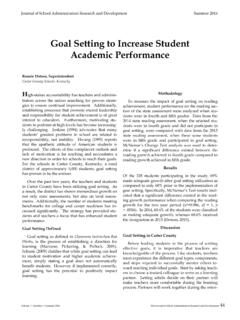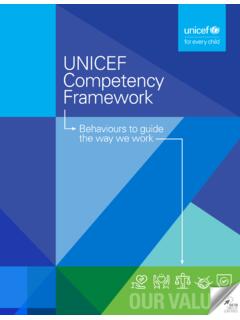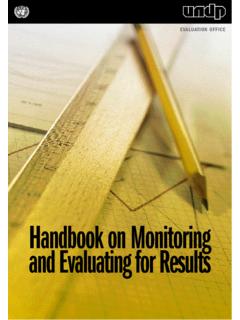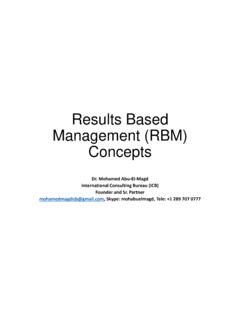Transcription of Leadership Framework and Competency Model
1 Leadership Framework and Competency Model 2 Introduction The KIPP Leadership Framework and Competency Model describes the competencies and behaviors considered most important to the performance of KIPP Executive Directors, Principals, Vice Principals/Deans and Grade Level Chairs/other teacher leaders, leaders in our regional shared services teams and KIPP Foundation staff. Our Leadership Framework is the high-level category architecture that assists in organizing our competencies and showing how those competencies relate to one another. A Competency can be defined as a cluster of related knowledge, skills and attitudes that affects a major part of one s job (a role or responsibility), that correlates with performance on the job, that can be measured against well-accepted standards, and that can be improved via training and development (Parry, 1996, ).
2 Every Competency in this Model includes key behaviors that make up the Competency . The key behaviors within each Competency describe the actions a leader takes that demonstrate proficiency in that Competency . This Model lays the foundation for several associated tools that will enable us to more effectively select, develop, evaluate, retain, and promote Leadership at KIPP. Leadership development tools associated with this Model include evaluation tools, goal-setting tools, 360 feedback tools, proficiency and Leadership development roadmaps, realistic job preview tools, interview protocols, and selection rubrics. Description of the Framework and Competency Model Effective KIPP leaders Drive results , Build Relationships, and Manage People. They do so in order to Prove the Possible for our students. As such, we ve organized our core Framework and competencies into these four categories.
3 Every individual also has critical role-specific competencies that may vary by role across regions and as you cross from school Leadership into regional Leadership . Essential competencies such as Instructional Leadership and Operations Management fit in this category. The Role-specific Competencies category rings the core competencies because these competencies often make up a very visible part of an individual s role and because they often rely upon many of the underlying core competencies. The Prove the Possible category and Student Focus Competency are at the middle of our Model , helping to always center the efforts of our leaders with a constant focus on what s best for students. The Drive results category includes core competencies that are directly associated with the individual s ability to produce exceptional outcomes and their ability to Model and support others in producing exceptional outcomes.
4 The Build Relationships category includes competencies that enable our leaders to work effectively with others. The Manage People category includes competencies that all leaders must demonstrate to ensure that staff and team performance are excellent. Role-specific Competencies include specialized knowledge and skills that are extremely important and highly visible to some, but not all Leadership roles at KIPP. For example KIPP Executive Directors and Principals must demonstrate operational skills and knowledge that are not required for KIPP Grade Level Chairs. This category allows flexibility for regional organizations to apply this Model to Shared Services Team members whose roles may also require essential domain expertise. 3 Background and Research Base The KIPP Leadership Competency Model is both empirically derived and heavily research-based.
5 To create this Model we relied partly upon the practical experience of high performing KIPP leaders at all levels and those at KIPP Foundation who work with those leaders. Through both discussions and focus groups, our leaders offered perspective on what competencies are most important to their effectiveness. Focus groups validated this Model by providing role-specific examples of every key behavior in the Model . We also relied significantly upon research in the organizational, business, and education domains that indicated which competencies and behaviors are most tied to effective Leadership , management and student achievement. This research helped us to both prioritize competencies and structure the key behaviors that demonstrate proficiency in those competencies. Appendix A contains a list of the research base that has been referenced to build this Model .
6 4 PROVE THE POSSIBLE - Student Focus Key Behaviors: An Effective KIPP : HIGH EXPECTATIONS. Expresses high expectations for all students, and expresses belief in their potential to complete college and succeed in life. : STUDENT BEST INTERESTS. Seeks to understand the needs and motivations of students, and makes decisions with student best interests and needs in mind. Expects teammates and employees to do the same. : COMMITMENTS. Keeps commitments made to students and ensures that others do the same. : RESPECT. Establishes and maintains a culture where students are treated with respect. : RELATIONSHIPS. Establishes and maintains strong relationships with students, and ensures employees do the same. DRIVE results - Achievement Orientation Key Behaviors: An Effective KIPP : CHALLENGING GOALS. Demonstrates high expectations by setting challenging goals for him or herself and others.
7 : INITIATIVE. Takes initiative, going above and beyond typical expectations and making necessary sacrifices to achieve exceptional results . : FOLLOW THROUGH. Follows through on commitments and promises with an appropriate sense of urgency. : RESILIENCE. Demonstrates tenacity, persevering through significant challenges to reach goals. Supports perseverance in others. : FLEXIBILITY. Demonstrates flexibility when plans or situations change unexpectedly. Effectively adjusts plans to achieve intended outcomes. : FOCUS ON results . Focuses upon results and how they are achieved. Does not confuse effort with results . DRIVE results - Continuous Learning Key Behaviors: An Effective KIPP : LEARNING. Takes responsibility for behavior, mistakes, and results , learns from successes and failures, and teaches others to do the same. : RISK TAKING.
8 Takes calculated risks and teaches others to do the same. : DATA-BASED IMPROVEMENTS. Uses data to accurately assess areas for improvement and teaches others to do the same. : RESEARCH. Uses research to inform practices. : IMPROVEMENT. Continuously and humbly seeks opportunities for personal and organizational improvement. Proactively solicits and willingly accepts assistance. : INNOVATION. Values and encourages creative and innovative ideas. : SHARING. Promotes and contributes to a culture of sharing effective practices within the organization and across the KIPP network. 5 DRIVE results - Critical Thinking and Problem Solving Key Behaviors: An Effective KIPP : GATHERING INFORMATION. Gathers information from multiple relevant sources and stakeholders when problem-solving. : SORTING OUT COMPLEXITY. Identifies useful relationships among complex data from unrelated areas.
9 : ANTICIPATING PROBLEMS. Anticipates and identifies problems in a timely manner. : BREAKING DOWN INFORMATION. Breaks complex information and problems into parts. : ANALYSIS. Analyzes, reflects upon, synthesizes, and contextualizes information. : WEIGHING OPTIONS. Weighs pros and cons of multiple options to solve complex problems. DRIVE results - Decision-Making Key Behaviors: An Effective KIPP : PROCESSES. Establishes decision-making processes, communicating about how decisions will be made and who has input, and ensuring that decisions are made by individuals best suited to make them. : CONSEQUENCES. Considers both the longer-term and unintended consequences of potential decisions. : SENSE OF URGENCY. Makes timely decisions, using intuition as well as data in the face of ambiguity. : COMMUNICATING. Timely conveys decisions to relevant stakeholders and takes follow-up actions to support decisions.
10 : DIFFICULT CHOICES. Willingly makes and stands by controversial decisions that benefit the organization. Shares understanding of the rationale for decisions, particularly when consensus cannot be reached. DRIVING results - Planning and Execution Key Behaviors: An Effective KIPP : BACKWARD PLANNING. Methodically backward plans to achieve short- and long-term goals. : RESOURCES. Accurately scopes and secures resources needed to accomplish projects. : PRIORITIZING. Manages time and resources effectively, prioritizing efforts according to organizational goals. : ACCOUNTABILITY. Regularly compares actual progress to planned milestones and adjusts plans accordingly, holding him or herself and others accountable for achieving intended outcomes. : CONTINGENCY PLANS. Proactively develops contingency plans in advance of potential or unforeseen circumstances.











